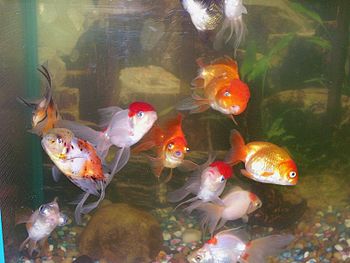 |
| 'A School of Fancy Goldfish (Photo credit: Wikipedia) |
I find it's helpful to use the analogy of your own house. Imagine you doubled the number of people living there. And then you couldn't clean it for several days. What would it be like? How would you react to that?
Oh yes, you can't open the windows or doors either. You are stuck with the same amount of oxygen in there as before. How would it feel?
Now imagine your goldfish. They are in a man-made artificially-constrained space (an aquarium). They are swimming in a limited amount of water and, like babies, they eat and excrete. But unlike babies, they can't cry and be heard if they are in distress.
Many people assume that when they go to a pet store and see fifty small goldfish in an aquarium that it means it is OK to buy a whole bunch of goldfish. And then keep them in one small tank at home.
Unfortunately, what they don't realize is:
- Pet shops retail goldfish fast so they can keep large numbers - for short periods - in smaller aquariums
- Young goldfish ("fry") are usually very small so you can keep a large number of them together for a few weeks
- Goldfish aquariums are usually cleaned very frequently (daily) in pet stores to remove uneaten food and poo
- When you get goldfish back home, they will start to grow very quickly. In fact, you'll be amazed to wake up one day and see how much they have grown
My rule of thumb: a 54-liter tank for a maximum of 2 average-size goldfish. The larger the aquarium, the better. You can never have an aquarium that is too big.
So why is overcrowding such a hazard for your goldfish?
Let me give you seven reasons why:
- The waste products of excretion reduce the amount of available oxygen and cause ammonia build up
- This means goldfish become poisoned by the water they are living and "breathing" in
- As ammonia levels build up and as the goldfish continue to grow, there is less oxygen available in the aquarium
- Goldfish will begin to gulp at the surface or start to develop a host of common goldfish sickness problems
- They begin to suffer from oxygen starvation
- Without adequate room to move, breathe or play the fish begin to suffocate
- Eventually, the combination of stress and oxygen starvation leads to death
Here are a common mistake goldfish keepers make: just because the aquarium water looks clear does not mean it is clean or healthy for your goldfish. When a fish suffers from ammonia or nitrate poisoning, then what's happening is that the concentration of ammonia (a clear colorless liquid) is becoming higher. The water looks clear, but it is actually poisonous. You can only be sure it is safe by using an ammonia testing kit - and conducting regular water changes.
It's also worth noting that "goldfish stress" is a very real phenomenon and can result from several reasons. Again, even if you're not agoraphobic, imagine you are jammed into a small space with a bunch of people. How would you feel? I remember being stuck on a train once on a hot Summer's day. It was so crowded that I got hemmed in against the wall: I couldn't move. I remember stress levels rising fast...
Goldfish actually experience chemical changes under stressful conditions. They are designed to release growth-stunting hormones in hostile environments. And you don't want to be unintentionally creating a "hostile" environment in your aquarium - by having too many fish.
In the worst cases, goldfish get so big they can't physically turn around in an aquarium. They get stuck in the same position. They can't feed properly and become distressed.
Finally, your goldfish need plenty of space to move, swim and play. You can't expect them to be happy if you don't give them the room to move about. It'll be a lot more enjoyable for you to watch them moving gracefully. It gives them the chance to engage in a normal range of healthy behaviors. These are fascinating to observe (and watching goldfish is proven to bring your blood pressure down too).
Richard Haggerty is the author of "The Goldfish Expert" and runs a popular Goldfish Care blog. To get a Free Special Report on avoiding the shocking dangers of bad goldfish care - and the pros and cons of different goldfish treatments - visit http://www.richardhaggerty.co.uk/GoldfishExpert/
Article Source: EzineArticles |






